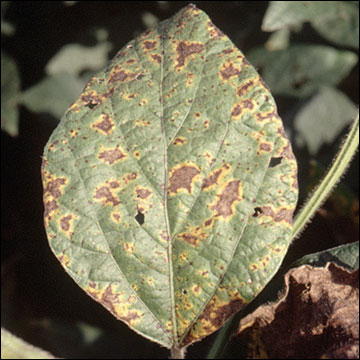Septoria brown spot
Septoria glycines
 Upper leaf surface
Upper leaf surface
 Lower leaf surface
Lower leaf surface
Upper leaf surface symptoms
Septoria brown spot develops as small, angular to somewhat circular reddish brown to brown spots. The individual spots can merge, forming irregular shaped, brown blotches on the leaves. In the dead tissue of older lesions, small dark specks (fruiting bodies of the causal pathogen) may be evident.
Lower leaf surface symptoms
Lesions will be evident as brown spots of varying sizes and shapes on the lower leaf surface.
Canopy symptoms
Septoria brown spot usually begins on the unifoliolate and lower trifoliolate leaves. Under favorable conditions the disease will spread into the upper canopy. Infected leaves may yellow and drop prematurely.
Weather
Warm, wet weather favors disease development. Symptoms develop over a temperature range of 59-86 degrees Fahrenheit. Spores are spread by wind and splashing rain. The spread of brown spot is restricted by dry weather.
Survival
The brown spot pathogen survives in infested residues left on the soil surface and may be seedborne.
Distribution in Missouri
Septoria brown spot occurs throughout Missouri. Most years it may occur early in the season and then redevelop close to harvest. Brown spot may be more severe when soybeans are planted into soybean residue or in years when moisture is abundant throughout the season.